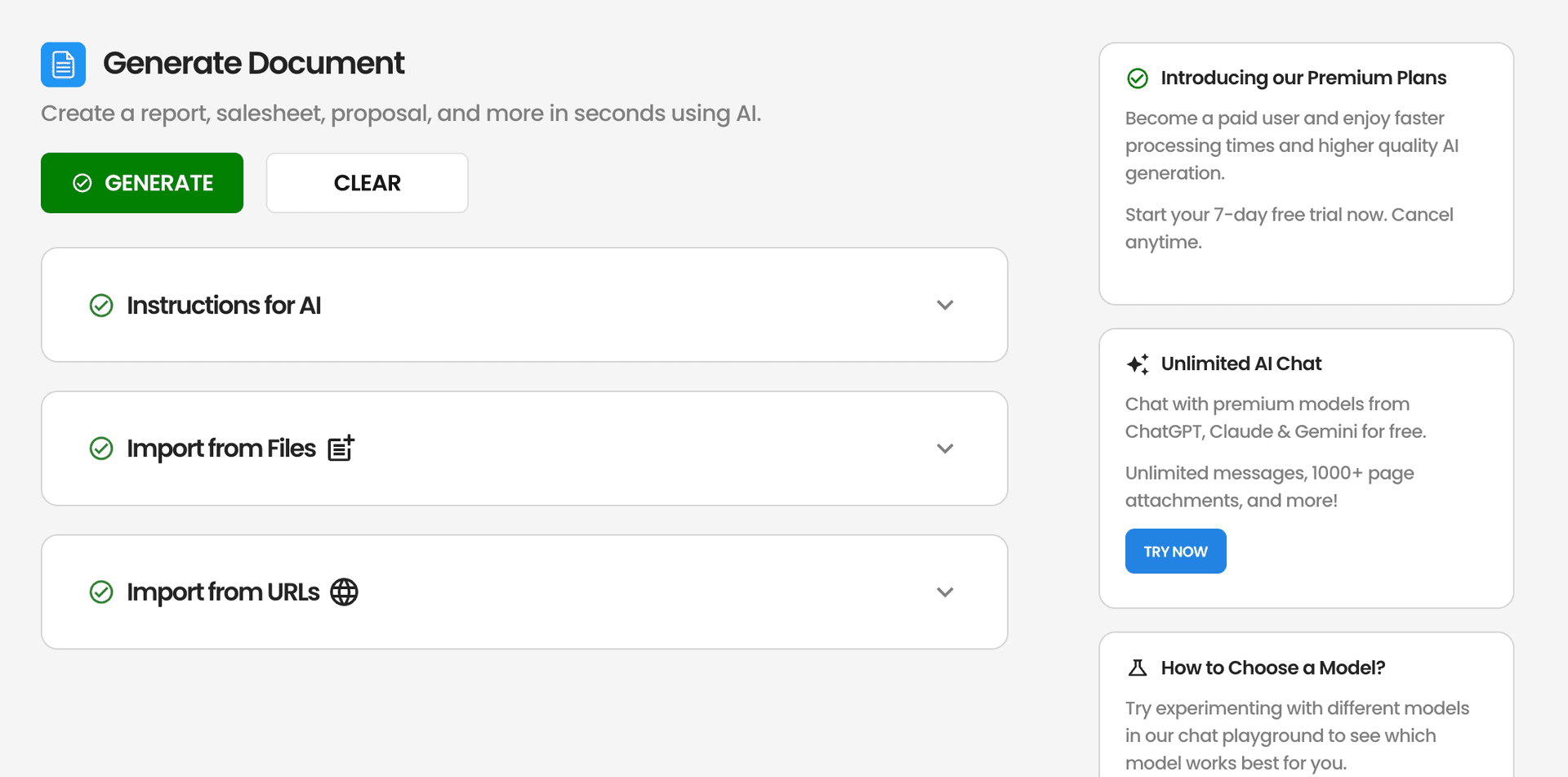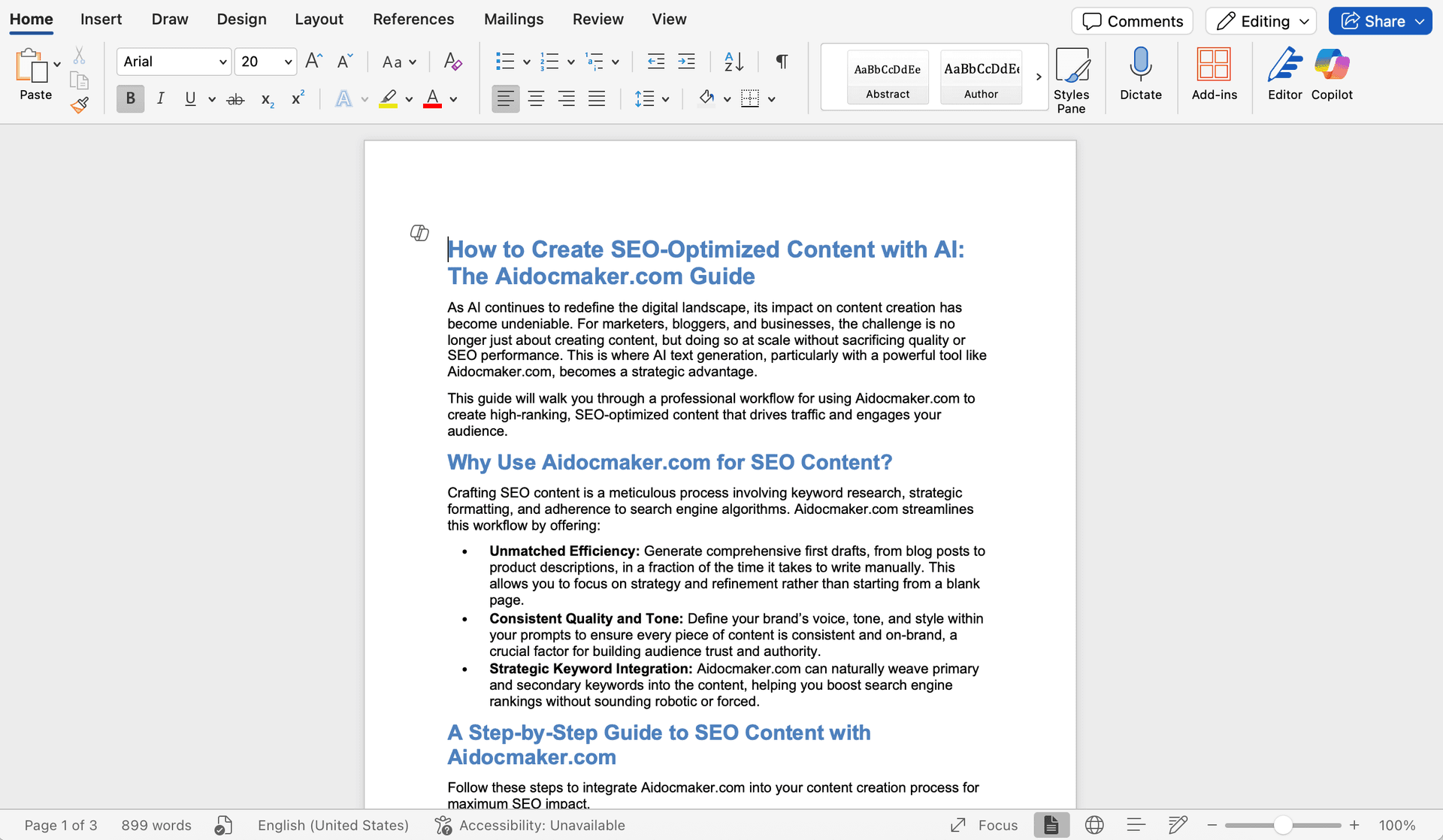The AI Content Critic: A Publisher's Guide to Evaluating and Elevating Output from an AI Word Generator
The AI Content Critic: A Publisher's Guide to Evaluating and Elevating Output from an AI Word Generator
The rise of the AI word generator has been nothing short of revolutionary for publishers, content marketers, and digital agencies. Tools like those on Aidocmaker.com offer the incredible promise of content velocity—the ability to produce reports, articles, and marketing copy at a scale previously unimaginable. But as we embrace this new era of efficiency, the role of the publisher is not diminished; it is transformed. The focus shifts from creation to curation, from writing to critical evaluation.
While an AI word generator can produce a draft in minutes, that draft is just the beginning. It lacks the nuanced understanding, critical eye, and ethical judgment that define high-quality, trustworthy content. The modern publisher must become an expert AI Content Critic, armed with the skills to evaluate, refine, and elevate AI-generated text. This guide provides a comprehensive framework for publishers to navigate this new landscape, ensuring that the content they produce is not only fast but also accurate, authoritative, and aligned with their brand.
The Publisher's New Role: From Creator to Critic
The core function of a publisher has always been to ensure quality and build trust with an audience. With the integration of AI, that function remains, but the methodology changes. Instead of spending hours staring at a blank page, the publisher's time is now leveraged for higher-value tasks: strategic refinement, factual verification, and the infusion of unique human insight. This is the essence of the "human-in-the-loop" model—a partnership where AI handles the heavy lifting of drafting, and the human expert provides the critical oversight and creative spark.
Embracing this role means developing a new set of skills centered on critical evaluation. You are no longer just a writer or an editor; you are the ultimate quality control specialist, the guardian of your brand's voice, and the final arbiter of what is ready for your audience.

A Practical Framework for Evaluating AI-Generated Content
To effectively evaluate content from an AI word generator, you need a systematic approach. A vague sense that "something feels off" is not enough. A rigorous evaluation framework ensures that every piece of content meets your standards. Here are the key pillars of that framework.
1. Factual Accuracy and Verification
This is the most critical step. Large language models (LLMs) are powerful, but they are not infallible. They can and do produce incorrect information, a phenomenon known as "hallucination." As noted in guidelines from Harvard University, AI-generated content can be inaccurate, misleading, or entirely fabricated. As a publisher, you are responsible for the accuracy of everything you publish.
- Cross-Check All Facts: Treat every statistic, date, name, and claim as unverified until proven otherwise. Cross-reference information with multiple, independent, and authoritative sources.
- Verify Sources: AI can invent citations and references that look convincing but are entirely fake. Use research databases like JSTOR or Google Scholar to confirm that cited sources actually exist and support the claims being made.
- Question Everything: Adopt a healthy skepticism. If a claim seems too good to be true or surprising, it warrants extra scrutiny.
2. Originality and Plagiarism
Publishing contracts almost universally require authors to warrant that their work is original. As the Authors Guild points out, AI-generated text is not considered "original" to you. While most modern AI word generators are designed to produce unique content, it's still essential to check for plagiarism.
- Use Plagiarism Checkers: Run the AI-generated text through a reliable plagiarism checker to ensure it doesn't inadvertently copy existing content.
- Ensure Substantive Originality: Go beyond simple text matching. Does the article present a fresh perspective, or does it merely rehash the top-ranking search results in a slightly different order? Your goal is to add value, not just volume.
3. Tone, Style, and Brand Alignment
An AI can mimic a tone, but it can't truly understand your brand's voice. A generic, robotic tone is a clear sign of unedited AI content. Your brand's voice is its personality—is it witty, academic, formal, or encouraging? The AI-generated draft must be refined to align perfectly with it.
Prompting Tip: The evaluation process starts with the prompt. The more detailed your instructions on tone and style, the better the initial draft will be. For a complete guide, read our article on how to optimize prompts for AI document generation.
4. Structure, Readability, and Logical Flow
A well-structured article is crucial for both user experience and SEO. An AI can generate headings and paragraphs, but it may not create the most logical flow. As outlined in research guides on evaluating AI, it's important to ensure arguments are presented logically and make sense.
- Check the Narrative Arc: Does the introduction set the stage effectively? Do the arguments build on each other logically? Does the conclusion provide a satisfying summary?
- Improve Readability: Break up long, dense paragraphs. Use bullet points, numbered lists, and bold text to make the content scannable and easier to digest.
- Ensure Coherent Transitions: Read the transitions between paragraphs and sections. Do they flow smoothly, or do they feel abrupt and disjointed?
5. Bias and Ethical Considerations
AI models are trained on vast datasets from the internet, which contain a wide range of human biases. These biases can inadvertently find their way into the generated text. As a responsible publisher, it is your job to identify and remove them.
- Check for Stereotypes: Review the text for any language that perpetuates harmful stereotypes related to gender, race, age, or socioeconomic status.
- Ensure Balanced Perspectives: Does the content present a one-sided view of a complex issue? Strive to offer a balanced and nuanced perspective where appropriate.
Elevating AI Content: From a Good Draft to a Great Article
Once you've verified that the AI-generated draft is accurate, original, and on-brand, the next step is to elevate it. This is where you infuse the content with the human elements that an AI cannot replicate.
1. Inject Your Unique Expertise and Insights
The AI provides the foundation; you provide the soul. Your personal experiences, expert opinions, and unique anecdotes are what will make the content truly valuable and differentiate it from the competition. Add your own stories, case studies, and practical examples that an AI could never know.
2. Strategic Keyword and Semantic Integration
While the AI can be prompted to include keywords, a human touch is needed to ensure they are integrated naturally. Modern SEO is about semantic relevance, not just keyword density. Review the text to ensure your primary and secondary keywords flow conversationally within the narrative, directly addressing search intent. For more on this, see our guide on using AI to write SEO-optimized content.
3. Build Authority with Strategic Linking
A strong linking strategy is vital for SEO and user trust. The AI-generated draft won't have this built-in.
- Internal Links: Link to other relevant articles on your site. This helps users discover more of your content and signals to search engines the relationship between your pages.
- External Links: Link out to authoritative, non-competing sources to support your claims. As noted by industry experts at Clarivate, this demonstrates that your content is well-researched and trustworthy.

Conclusion: The Indispensable Human Critic
An AI word generator is an incredibly powerful tool that can revolutionize a publisher's workflow, unlocking new levels of productivity. It can serve as a tireless research assistant, a brilliant brainstormer, and a lightning-fast drafter. But it is not a replacement for the human publisher.
By embracing the role of the AI Content Critic, you can harness the power of AI without sacrificing quality, accuracy, or integrity. By applying a rigorous evaluation framework and infusing every piece of content with your unique human expertise, you can create articles that are not only produced efficiently but are also trustworthy, valuable, and deeply engaging for your audience. This partnership—between the speed of AI and the critical judgment of the human expert—is the future of digital publishing.
Ready to see how an AI word generator can fit into your workflow? Explore the tools on Aidocmaker.com and start creating better content, faster.
Aidocmaker.com
Aidocmaker.com is an AI company based in Silicon Valley building AI productivity tools. Our team has a background in AI and machine learning, with years of industry experience building AI software.
One Platform, Multiple AI Apps
Apps powered by AI for creating reports, presentations, voiceovers, chatting with PDFs, and more. All on a single platform.
Start Improving Your Productivity with AI Today
Sign up now and see how Aidocmaker.com can transform your productivity.
Get StartedGenerate with AI
Free AI Tools
AI-generated content can contain mistakes. Consider checking important information.
* Institutional logos displayed on this page represent users of our services and are shown for informational purposes. They do not imply partnership or endorsement by these organizations.
© 2025 Aidocmaker.com. Based in California.
